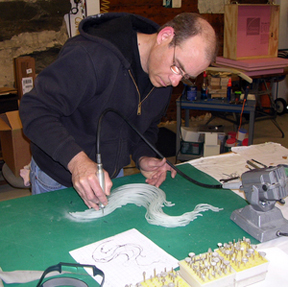
William LeQuier has evolved from a traditional studio glass blower to a sculptor of unique glass art. His style and form have changed several times over the years; yet there is an underlying continuity in his focus and development process that puts his current work in context with his work of years past.
LeQuier graduated Southern Connecticut State University (SCSU) in 1975 with a BS in Art Education. While a student, LeQuier participated in the glass blowing program introduced at SCSU in 1973. At that time small studio glass blowing was in its infancy and SCSU was one of the first schools in Connecticut to include the medium as part of its art curriculum.
In 1976, William LeQuier and his wife Mary Angus, in partnership with two other glass artists, established Bittersweet Glassworks, a glass blowing studio in Branford, CT. In 1983 LeQuier and Angus moved their studio to Readsboro, VT.
After years of blowing art glass vessels, LeQuier began to experiment with sandblasted surface designs. “I was intrigued with the sandblasting process. I found that I could carve the glass to generate a myriad of textures similar to results of accelerated natural erosion.” Over time his sandblasted geometric patterned vessels evolved to organic sculptures carved in relief from blown glass forms.
“My experimentation with varying depths of carving combined with different resist materials yielded unexpected and exciting results and gave me new directions to explore.” Inspired by the diversity in form and color of undersea creatures, many of these works were reminiscent of sea urchins, sponges, anemones and their environments.
LeQuier’s appreciation of the strength and serendipity of nature has moved his work in a new direction. While observing stacks of salvaged glass shelving, he began to think of a different way to work with glass. He saw the raw material for a series of sculptures that were multi-layered constructions. Inspired by quickly rendered sketches, LeQuier is able to transform a mundane material to organic forms conveying movement and emotion.
Free flowing strands of carved glass are laminated with other layers to create depth and a complexity of intersecting lines. These sculptures of fluid motion vividly represent a momentary event in nature.
For information on more available work from this artist, please contact us.